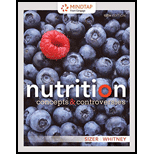
Interpretation:
Whether the statement ‘commercial shakes as well as energy bars are considered as the best protein source for weight- loss’ is true or false.
Concept Introduction:
The commercial shakes and energy bars are the nutritional supplement that adds protein and other essential nutrients to the diet. They are isolated from the protein sources like eggs, soy, milk, etc.
Answer to Problem 1RQ
Correct Answer:
The correct answer is false.
Explanation of Solution
Commercial shakes and energy bars are not the best protein sources to support weight loss efforts because permanent weight loss is often the result of diet and exercise both. They are fortified with minerals and essential vitamins that are present in vegetables and fruits.
Commercial shakes also have high amount of saturated fats and over extended period of these could be harmful for the body.
It could be concluded that commercial shakes and energy bars are not the best protein sources to support weight loss efforts.
Want to see more full solutions like this?
 Nutrition: Concepts and Controversies - Standalo...Health & NutritionISBN:9781305627994Author:Frances Sizer, Ellie WhitneyPublisher:Brooks Cole
Nutrition: Concepts and Controversies - Standalo...Health & NutritionISBN:9781305627994Author:Frances Sizer, Ellie WhitneyPublisher:Brooks Cole NutritionHealth & NutritionISBN:9781337906371Author:Sizer, Frances Sienkiewicz., WHITNEY, ElliePublisher:Cengage Learning,
NutritionHealth & NutritionISBN:9781337906371Author:Sizer, Frances Sienkiewicz., WHITNEY, ElliePublisher:Cengage Learning, Nutrition Through The Life CycleHealth & NutritionISBN:9781337919333Author:Brown, Judith E.Publisher:Cengage Learning,
Nutrition Through The Life CycleHealth & NutritionISBN:9781337919333Author:Brown, Judith E.Publisher:Cengage Learning, Comprehensive Medical Assisting: Administrative a...NursingISBN:9781305964792Author:Wilburta Q. Lindh, Carol D. Tamparo, Barbara M. Dahl, Julie Morris, Cindy CorreaPublisher:Cengage Learning
Comprehensive Medical Assisting: Administrative a...NursingISBN:9781305964792Author:Wilburta Q. Lindh, Carol D. Tamparo, Barbara M. Dahl, Julie Morris, Cindy CorreaPublisher:Cengage Learning





